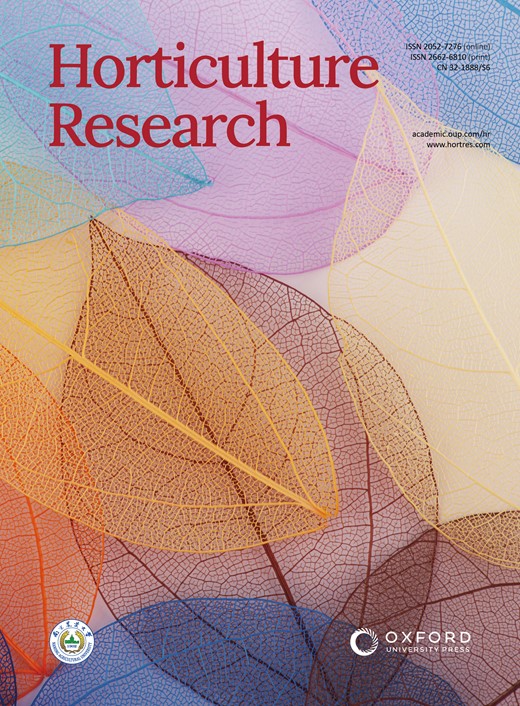Natural variation in MdNAC5 contributes to fruit firmness and ripening divergence in apple
IF 8.5
1区 农林科学
Q1 Agricultural and Biological Sciences
引用次数: 0
Abstract
Fruit firmness is an important trait for characterizing the quality and value of apple. It is also serves as an indicator of fruit maturity, as it is a complex trait regulated by multiple genes. Re-sequencing techniques can be employed to elucidate variations in such complex fruit traits. Here, the whole genomes of 294 F1 hybrids of ‘Fuji’ and ‘Cripp's Pink’ were re-sequenced, and a high-density bin-map was constructed using 5,014 bin markers with a total map distance of 2,213.23 cM and an average map distance of 0.44 cM. Quantitative trait loci (QTLs) of traits related to fruit were mapped, and an A-T allele variant identified in the coding region of MdNAC5 was found to potentially regulate fruit firmness and ripening. The overexpression of MdNAC5A resulted in higher production of methionine and 1-aminocyclopropanecarboxylic acid compared to MdNAC5T, leading to reduced fruit firmness and accelerated ripening in apples and tomatoes. Furthermore, the activities of MdNAC5A and MdNAC5T were enhanced through their differential binding to the promoter regions of MdACS1 and MdERF3. Spatial variations in MdNAC5A and MdNAC5T caused changes in MdACS1 expression following their interaction with MdERF3. Ultimately, utilizing different MdNAC5 alleles offers a strategy to manipulate fruit firmness in apple breeding.MdNAC5的自然变异导致苹果果实坚硬度和成熟度的差异
果实坚实度是表征苹果质量和价值的一个重要性状。它也是果实成熟度的指标,因为它是由多个基因调控的复杂性状。重测序技术可用于阐明此类复杂果实性状的变异。本文对 294 个'富士'和'克里普粉红'F1 杂交种的全基因组进行了重测序,并利用 5,014 个二进制标记构建了高密度二进制图谱,总图谱距离为 2,213.23 cM,平均图谱距离为 0.44 cM。绘制了与果实相关性状的数量性状位点(QTLs)图,发现在 MdNAC5 编码区发现的 A-T 等位基因变异可能调控果实的坚硬度和成熟度。与 MdNAC5T 相比,MdNAC5A 的过表达会导致蛋氨酸和 1-aminocyclopropanecarboxylic acid 产生更多,从而导致苹果和番茄的果实硬度降低和成熟加速。此外,通过与 MdACS1 和 MdERF3 启动子区域的不同结合,MdNAC5A 和 MdNAC5T 的活性也得到了增强。MdNAC5A 和 MdNAC5T 与 MdERF3 相互作用后,MdNAC5A 和 MdNAC5T 的空间变化引起了 MdACS1 表达的变化。最终,利用不同的 MdNAC5 等位基因为苹果育种提供了一种控制果实硬度的策略。
本文章由计算机程序翻译,如有差异,请以英文原文为准。
求助全文
约1分钟内获得全文
求助全文
来源期刊

Horticulture Research
Biochemistry, Genetics and Molecular Biology-Biochemistry
CiteScore
11.20
自引率
6.90%
发文量
367
审稿时长
20 weeks
期刊介绍:
Horticulture Research, an open access journal affiliated with Nanjing Agricultural University, has achieved the prestigious ranking of number one in the Horticulture category of the Journal Citation Reports ™ from Clarivate, 2022. As a leading publication in the field, the journal is dedicated to disseminating original research articles, comprehensive reviews, insightful perspectives, thought-provoking comments, and valuable correspondence articles and letters to the editor. Its scope encompasses all vital aspects of horticultural plants and disciplines, such as biotechnology, breeding, cellular and molecular biology, evolution, genetics, inter-species interactions, physiology, and the origination and domestication of crops.
 求助内容:
求助内容: 应助结果提醒方式:
应助结果提醒方式:


